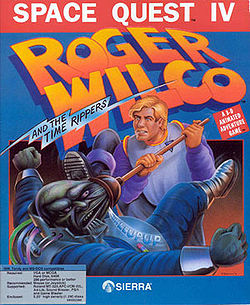- Space Quest IV: Roger Wilco and The Time Rippers
-
Space Quest IV: Roger Wilco and The Time Rippers 
Developer(s) Sierra Publisher(s) Sierra Designer(s) Mark Crowe and Scott Murphy Engine SCI Platform(s) DOS, Windows, Macintosh, Amiga, NEC PC-9801 Release date(s) 1991 Genre(s) Adventure Mode(s) Single-player Rating(s) ESRB: Kids to Adults Media/distribution 3.5" Floppy Disk or 5.25" Floppy Disk or CD System requirements 8088/8086 CPU, 640KB RAM, EGA, MCGA, Tandy/PCjr, or VGA graphics, Adlib, Game Blaster, PC speaker, PS/1 Audio Card, Roland MT-32, Sound Blaster, Tandy DAC (TL/SL), or Tandy/PCjr sound card
Space Quest IV: Roger Wilco and The Time Rippers was released on floppy disks on March 4, 1991, and released on CD-ROM in December 1992 with full speech support and featuring Laugh-In announcer Gary Owens as the voice of the narrator. It featured 256-color hand painted graphics and a fully mouse-driven interface. It was one of the first games to use motion capture animation. The game cost over US$1,000,000 to produce and sold more than its three predecessors combined. An Atari ST version was announced via Sierra Online's magazine, Sierra News Magazine, but was later canceled.[1]
Contents
Plot
In this installment, Roger embarks on a time-travel adventure through Space Quest games both past and future. An infomorph of reborn Sludge Vohaul from Space Quest XII: Vohaul's Revenge II chases Roger through time in an attempt to finally kill him. Roger also visits Space Quest X: Latex Babes of Estros (whose title is a parody of Infocom's game Leather Goddesses of Phobos) and Space Quest I; in the latter, the graphics and music revert to the style of the original game and Roger is threatened by a group of monochromatic bikers who consider Roger's 256 colors pretentious. None of the gameplay takes place in Space Quest IV.
Easter eggs
An easter egg in this game is accessed by entering the code in the time capsule as the top row of buttons in order from left to right. This transports Roger to the volcanic planet of Ortega from Space Quest III. Unfortunately, this time Roger is not wearing any thermal underwear, so if he steps out of the capsule, he melts. Much like SQI's Ulence Flats, Ortega (what little of it is seen) appears in SQIV using the graphical style of the earlier game.
Another easter egg near the end plays on the desktop format of Macintosh computers, featuring a toilet in place of a waste basket. Certain icons must be "flushed" down the toilet; however, if the icon "SQIV" is deleted in this way, the game exits. An additional icon, referring to King's Quest, brings up a message when "flushed" indicating that a massive amount of data has been deleted, referring obliquely to the large number of 3.5-inch disks early versions in that series required on some systems.
Ms. Astro Chicken
Ms. Astro Chicken: Flight of the Pullet is a computer game embedded within Space Quest IV. Ms. Astro Chicken appears within the context of the game in the form of an arcade game. It is a sequel of sorts to Astro Chicken, an arcade game that appeared in Space Quest III: The Pirates of Pestulon.
In Space Quest IV, the lead character, Roger Wilco, travels extensively in time, visiting locations in past Space Quest games as well as hypothetical "future" games. While in the world of Space Quest X: Latex Babes of Estros, Roger visits a mall arcade that contains Ms. Astro Chicken.
Gameplay, as it was in the original Astro Chicken, is simple. The player uses the arrow keys or mouse to maneuver a flying chicken. The chicken's enemies include flying squirrels, windpumps, shotgun-wielding hunters and hunting dogs. Dropping eggs on enemies immobilizes them and increases the player's score. After some time of playing the game, the arcade cabinet explodes, though this has no effect on the player or his progress in SQIV.
The game's presence within the game is somewhat bizarre. In Space Quest III, Roger defeated the Pirates of Pestulon and rescued the Two Guys from Andromeda, presumably ruining ScumSoft in the process. Additionally, the events of Space Quest X would have taken place decades after SQ III. Nevertheless, Ms. Astro Chicken bears the ScumSoft logo.
The game's name is a parody of the actual arcade game Ms. Pac Man. The Astro Chicken theme music is a variation on the Chicken Reel, a traditional folk song best known for its use in animated cartoons.
Reception
The game was reviewed in 1991 in Dragon #173 by Hartley, Patricia, and Kirk Lesser in "The Role of Computers" column. The reviewers gave the game 5 out of 5 stars.[2] The Lessers reviewed the Macintosh version of the game in 1992 in Dragon #179, also giving that version of the game 5 out of 5 stars.[3]
References
- ^ Staff (Spring 1991). "Atari ST Owners Set To Enjoy Two Brand New Products Plus Reillustrated Versions Of Two Classics In Spring '91", Sierra News Magazine. p. 13,22[dead link]
- ^ Lesser, Hartley, Patricia, and Kirk (September 1991). "The Role of Computers". Dragon (173): 55–60.
- ^ Lesser, Hartley, Patricia, and Kirk (March 1992). "The Role of Computers". Dragon (179): 57–62.
External links
Space Quest IV: Roger Wilco and the Time Rippers at MobyGames
Video games Space Quest: The Sarien Encounter · SQII: Vohaul's Revenge · SQIII: The Pirates of Pestulon · SQIV: Roger Wilco and The Time Rippers · SQV: Roger Wilco - The Next Mutation · SQ6: Roger Wilco in The Spinal FrontierDevelopers Categories:- 1991 video games
- Adventure games
- Amiga games
- DOS games
- NEC PC-9801 games
- Point-and-click adventure games
- ScummVM supported games
- Sierra Entertainment games
- Space Quest
Wikimedia Foundation. 2010.
